Gender Selection Dilemma in Fast Moving Consumer Goods (FMCG) Advertising: Insights from Eye-Tracking Research
Abstract
1. Introduction
2. Literature Review
- a)
- Male celebrity endorsements in advertising exhibit statistically higher perceived trustworthiness ratings compared to female celebrity endorsements.
- b)
- Male celebrities garner statistically greater perception of attractiveness ratings in advertisements than females, contributing to their overall credibility.
- c)
- Ads featuring male celebrities statistically demonstrate greater perceptions of expertise in comparison to ads with female celebrities, enhancing product credibility.
- a)
- Purchase intention is positively associated with the level of attention given to male celebrities.
- b)
- The greater the focus on a female celebrity, the stronger the inclination towards purchasing.
- a)
- Perceived Attractiveness
- b)
- Perceived Expertise
- c)
- Perceived Trustworthiness
- a)
- Perceived Attractiveness
- b)
- Perceived Expertise
- c)
- Perceived Trustworthiness
3. Methodology
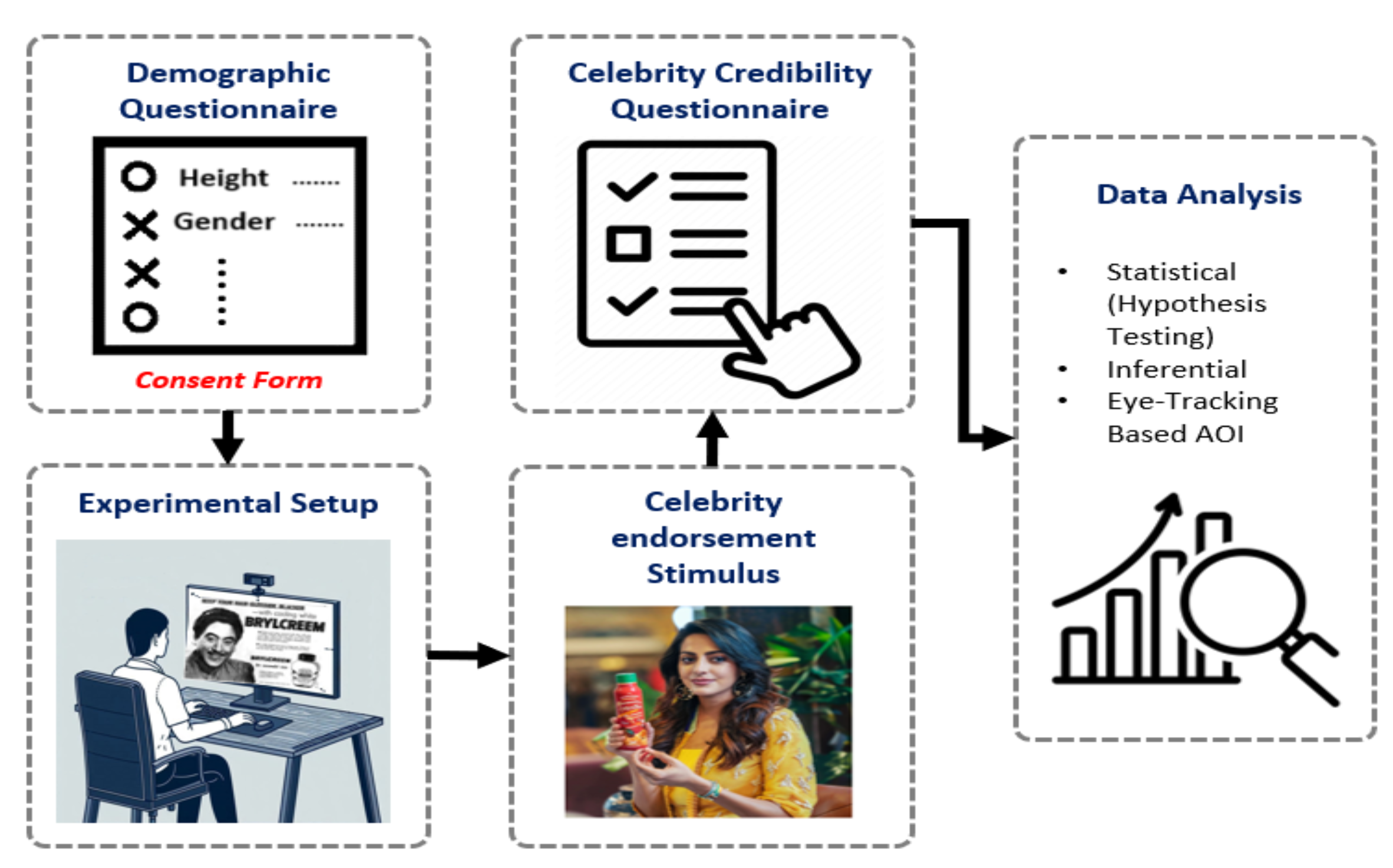
| Hypothesis | |
|---|---|
| H1 | There exists a statistically significant gender-based disparity in the allocation of visual attention by consumers, with a greater proportion directed towards advertisements featuring female celebrities than male celebrities. |
| H2 | The level of purchase intention generated by advertisements featuring male celebrities is statistically higher than that resulting from advertisements featuring female celebrities. |
| H3 | a) Male celebrity endorsements in advertising exhibit statistically higher perceived trustworthiness ratings compared to female celebrity endorsement b) Female celebrities garner statistically greater perception of attractiveness ratings in advertisements than males, contributing to their overall credibility. c) Ads featuring male celebrities statistically demonstrate greater perceptions of expertise in comparison to ads with female celebrities, enhancing product credibility. |
| H4 | a) Purchase intention is positively associated with the level of attention given to male celebrities. b) The greater the focus on a female celebrity, the stronger the inclination towards purchasing. |
| H5 | The level of attention directed towards male celebrities is positively linked to their credibility as Celebrity Endorser. a) Perceived Attractiveness b) Perceived Expertise c) Perceived Trustworthiness |
| H6 | The prominence of attention given to female celebrities is positively associated with their credibility in the public eye a) Perceived Attractiveness b) Perceived Expertise c) Perceived Trustworthiness |
3.1. Stimulus

3.2. Participants
3.3. Eye-Tracking
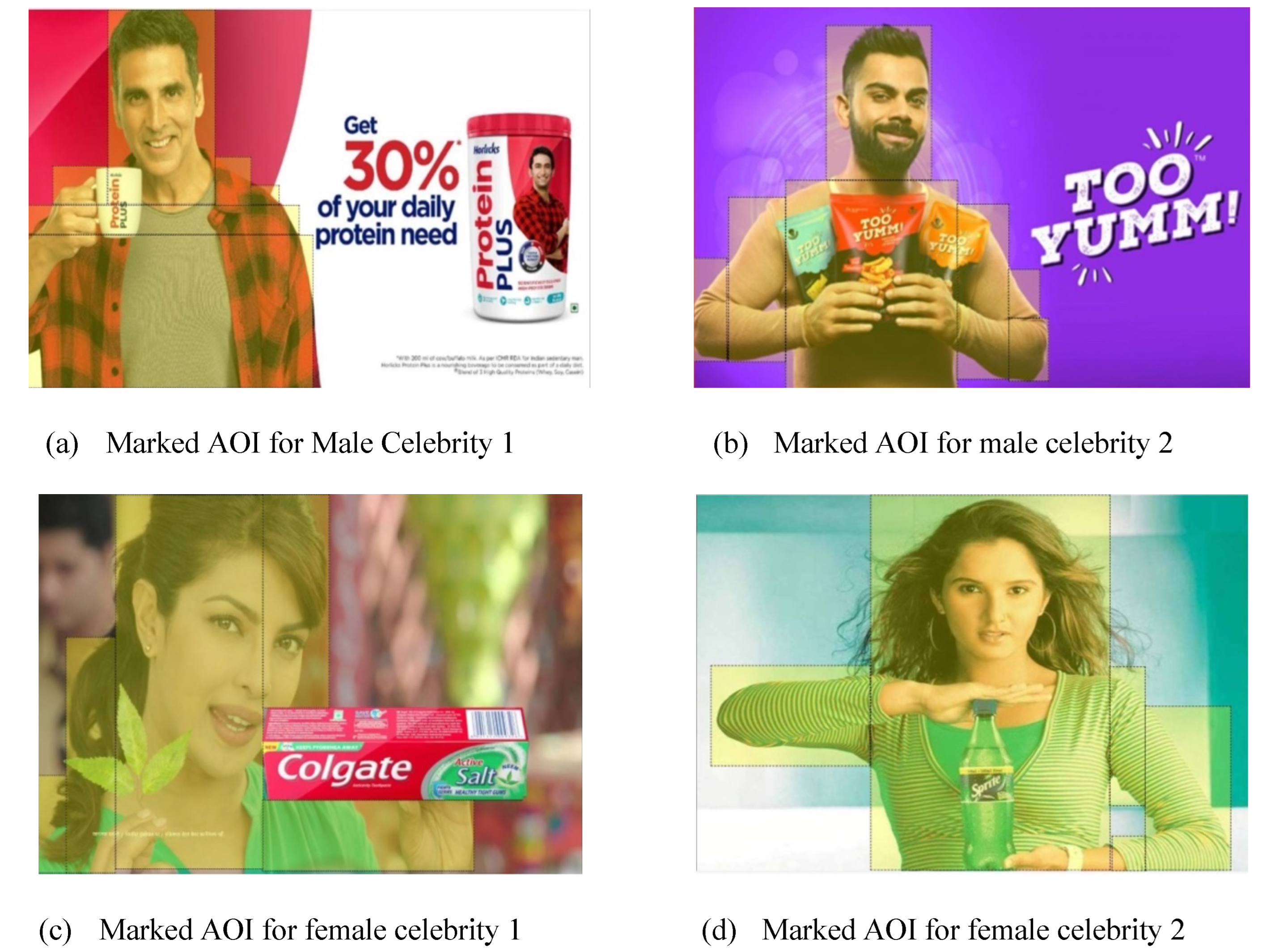
3.4. Self-Reported Study
Questionnaire
- i)
- Celebrity Credibility
- The celebrity that appears in the advertisement is Classy.
- The celebrity that appears in the advertisement is dependable.
- The celebrity that appears in the advertisement is expert.
- ii)
- Purchase intentions
- Product–probable, likely, certain, and chance,
- How likely are you to purchase the product?
- How probable is that you would purchase the product? How certain are that you will purchase the product?
- What is the chance that you will buy the product
4. Results
4.1. Socio-Demographic Data
| Scale | Frequency | Percentage | |
|---|---|---|---|
| Gender | Male | 43 | 50 |
| Female | 43 | 50 | |
| Total | 86 | ||
| Age(years) | 18–21 | 46 | 53.48 |
| 22–25 | 31 | 36.04 | |
| Above 25 | 9 | 10.46 | |
| Education | Up to 12th | 41 | 47.67 |
| Graduation | 26 | 30.23 | |
| Post-Graduation | 19 | 22.09 | |
| Monthly Income (INR) | 0–10 million | 67 | 77.90 |
| 10–50 million | 16 | 18.60 | |
| 51–100 million | 2 | 02.32 | |
| Above 100 million | 1 | 01.16 |
4.2. Eye Tracking Summary

4.3. Self-Reported Measure
- i)
- Purchase Intention
| Male Celebrity | Female Celebrity | |||
|---|---|---|---|---|
| Statistic | Fixation Count | Dwell Time (ms) | Fixation Count | Dwell Time (ms) |
| Mean | 10.930 | 3467.442 | 19.797 | 5420.971 |
| Variance | 37.716 | 5388244.770 | 36.150 | 4046503.819 |
| Standard deviation | 6.141 | 2321.259 | 6.013 | 2011.592 |
| Standard error of the mean | 0.470 | 177.511 | 0.460 | 153.830 |
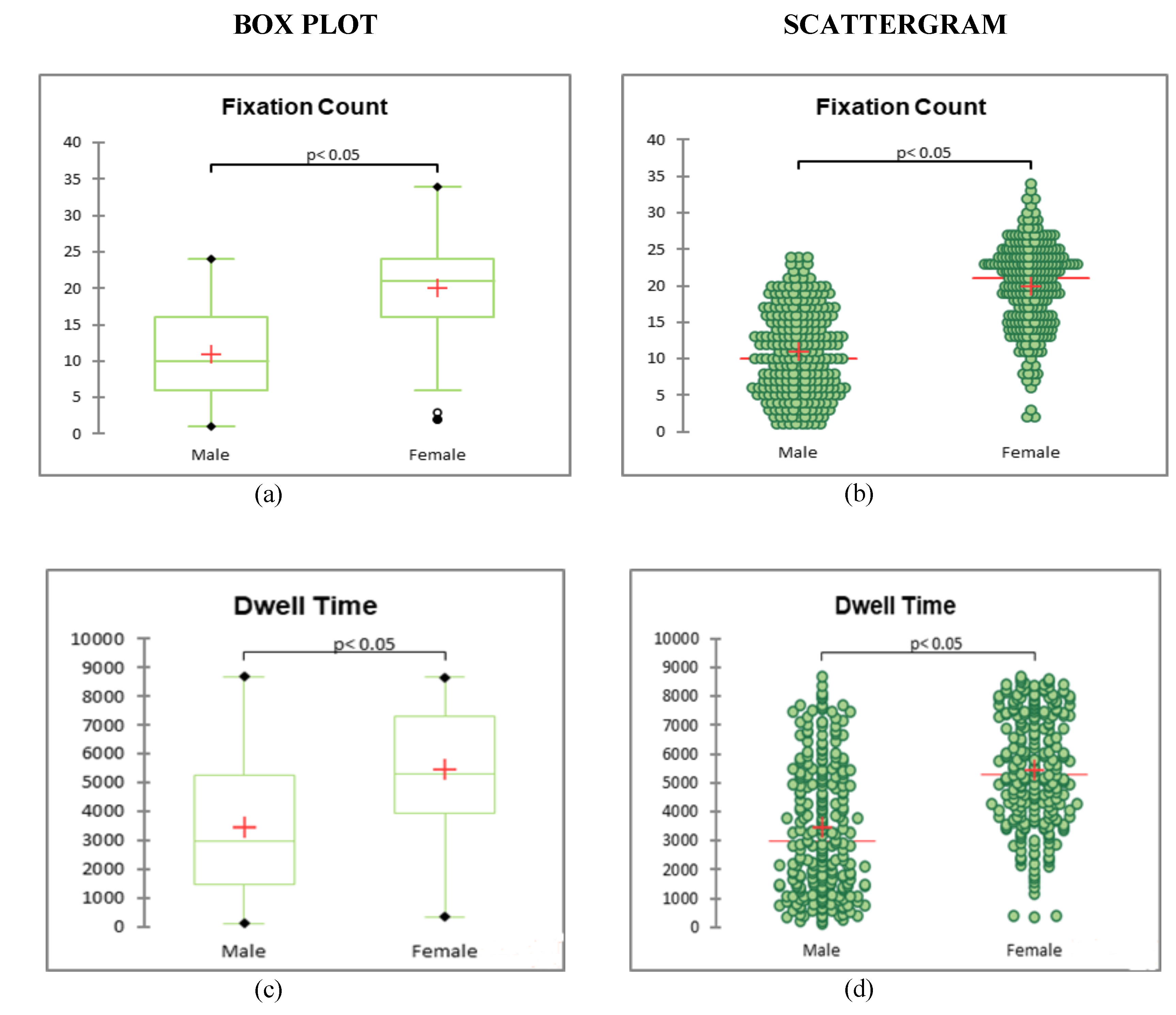
- ii)
- Celebrity Credibility
- a)
- Perceived Trustworthiness
| Celebrity Type | Statistic | Mean | Variance | Standard Deviation | S.E of the Mean |
|---|---|---|---|---|---|
| Male | Purchase Intention | 3.269 | 1.087 | 1.042 | 0.080 |
| Female | 3.389 | 0.790 | 0.889 | 0.068 | |
| Male | Attractiveness | 3.895 | 0.717 | 0.847 | 0.065 |
| Female | 3.999 | 0.736 | 0.858 | 0.066 | |
| Male | Expertise | 3.766 | 1.077 | 1.038 | 0.079 |
| Female | 3.413 | 1.080 | 1.039 | 0.079 | |
| Male | Trustworthiness | 3.519 | 0.986 | 0.993 | 0.076 |
| Female | 3.341 | 0.904 | 0.951 | 0.073 |
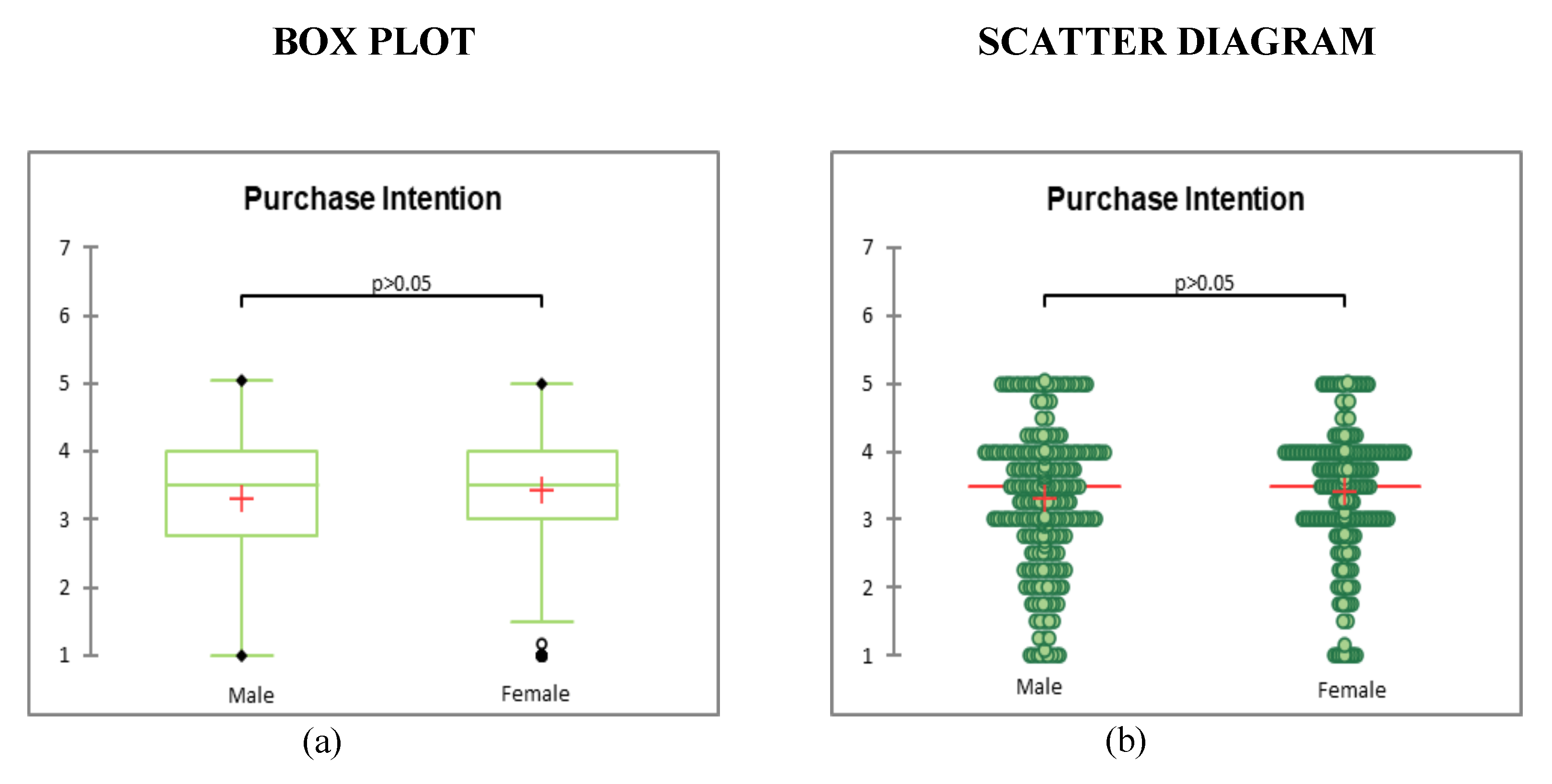
- b)
- Perceived Attractiveness
- c)
- Perceived Expertise
| Variables | Fixation Count | Dwell Time (ms) | Purchase Intention | Attractiveness | Expertise | Trustworthiness |
|---|---|---|---|---|---|---|
| Fixation Count | 1 | 0.973 | 0.254 | 0.088 | -0.031 | 0.027 |
| Dwell Time (ms) | 0.973 | 1 | 0.270 | 0.079 | -0.049 | 0.025 |
| Purchase intention | 0.254 | 0.270 | 1 | 0.339 | 0.286 | 0.349 |
| Attractiveness | 0.088 | 0.079 | 0.339 | 1 | 0.518 | 0.495 |
| Expertise | -0.031 | -0.049 | 0.286 | 0.518 | 1 | 0.660 |
| Trustworthiness | 0.027 | 0.025 | 0.349 | 0.495 | 0.660 | 1 |
| Variables | Fixation Count | Dwell Time (ms) | Purchase Intention | Attractiveness | Expertise | Trustworthiness |
|---|---|---|---|---|---|---|
| Fixation Count | 1 | 0.844 | -0.159 | -0.125 | -0.118 | 0.039 |
| Dwell Time (ms) | 0.844 | 1 | -0.255 | -0.204 | -0.191 | -0.043 |
| Purchase Intention | -0.159 | -0.255 | 1 | 0.216 | 0.218 | 0.290 |
| Attractiveness | -0.125 | -0.204 | 0.216 | 1 | 0.521 | 0.403 |
| Expertise | -0.118 | -0.191 | 0.218 | 0.521 | 1 | 0.676 |
| Trustworthiness | 0.039 | -0.043 | 0.290 | 0.403 | 0.676 | 1 |
| p-Value | |
|---|---|
| Fixation Count | <0.0001 * |
| Dwell Time | <0.0001 * |
| Purchase Intention | 0.179 |
| Trustworthiness | 0.008 * |
| Attractiveness | 0.068 |
| Expertise | <0.0001 * |
4.4. Neuromarketing and Self-Reported Measure
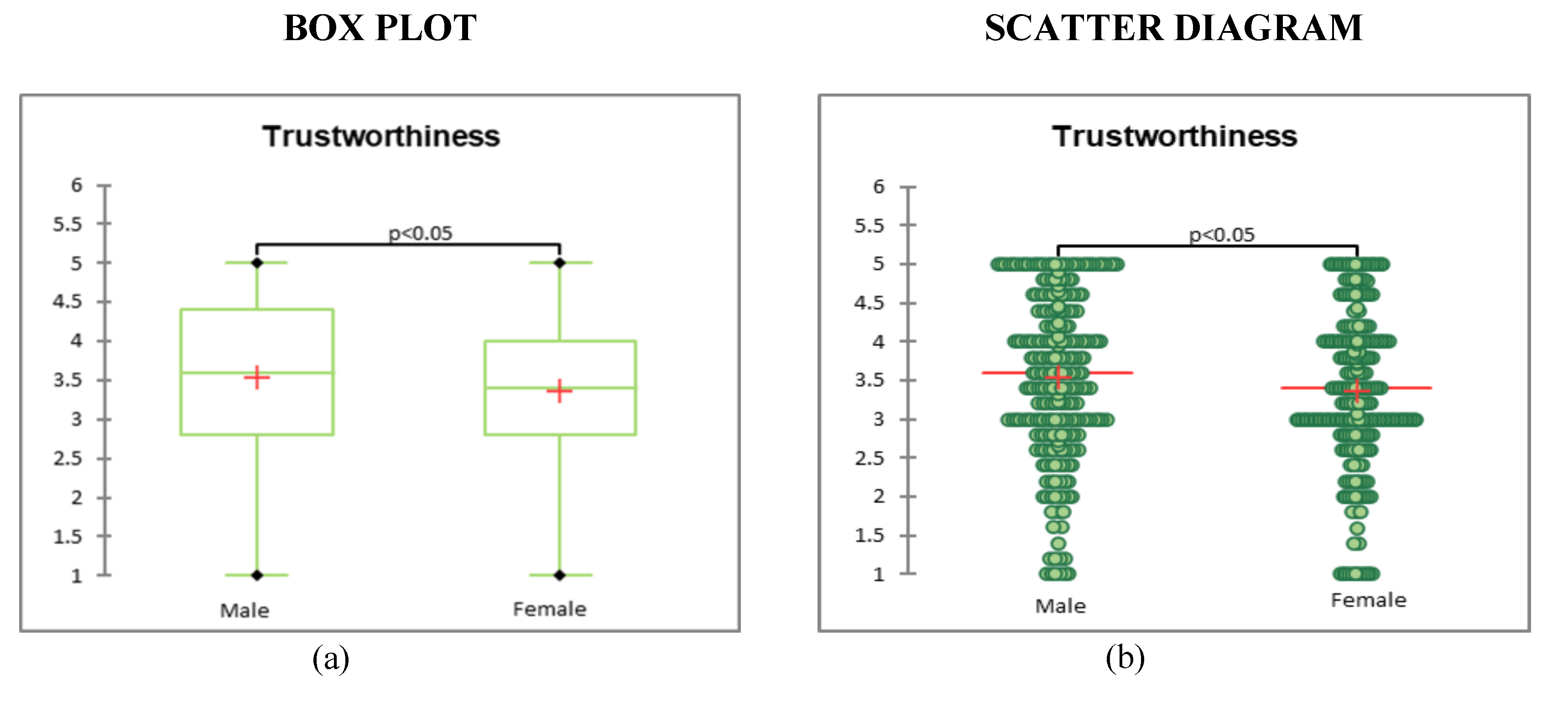

| Remarks | |
|---|---|
| H1 | Accepted |
| H2 | Not-Accepted |
| H3 | |
| H3a | Accepted |
| H3b | Not-Accepted |
| H3c | Accepted |
| H4 | |
| H4a | Accepted |
| H4b | Not-Accepted |
| H5 | |
| H5a | Accepted |
| H5b | Not-Accepted |
| H5c | Accepted |
| H6 | |
| H6a | Not-Accepted |
| H6b | Not-Accepted |
| H6c | Accepted |
5. Discussion
Limitations
Ethics and Conflict of Interest
References
- Adalı, G., F. Yardibi, Ş. Aydın, A. Güdekli, E. Aksoy, and S. Hoştut. 2024. Gender and Advertising: A 50-Year Bibliometric Analysis. Journal of Advertising. [Google Scholar] [CrossRef]
- AlFarraj, O., A. A. Alalwan, Z. M. Obeidat, A. Baabdullah, R. Aldmour, and S. Al-Haddad. 2021. Examining the impact of influencers’ credibility dimensions: Attractiveness, trustworthiness and expertise on the purchase intention in the aesthetic dermatology industry. Review of International Business and Strategy 31, 3: 355–374. [Google Scholar] [CrossRef]
- Allport, G. W. 2015. 2015.155561.Personality-A-Psychological-Interpretation.pdf.
- Arai, A., Y. J. Ko, and S. Ross. 2013. Branding athletes: Exploration and conceptualization of athlete brand image. Https://Doi.Org/10.1016/j.Smr.2013.04.003 17, 2: 97–106. [Google Scholar] [CrossRef]
- Ayala, N., A. Zafar, S. Kearns, E. Irving, S. Cao, and E. Niechwiej-Szwedo. 2023. The effects of task difficulty on gaze behaviour during landing with visual flight rules in low-time pilots. Journal of Eye Movement Research 16, 1: 1–16. [Google Scholar] [CrossRef]
- Basuroy, T. 2024. India: Share of FMCG advertising spend by channel 2023. Statista. https://www.statista.com/statistics/894075/india-share-of-fmcg-advertising-spend-by-channel/.
- Belanche, D., I. Cenjor, and A. Pérez-Rueda. 2019. Instagram Stories versus Facebook Wall: An advertising effectiveness analysis. Spanish Journal of Marketing—ESIC 23, 1: 69–94. [Google Scholar] [CrossRef]
- Beldad, A., S. Hegner, and J. Hoppen. 2016. The effect of virtual sales agent (VSA) gender—Product gender congruence on product advice credibility, trust in VSA and online vendor, and purchase intention. Computers in Human Behavior 60: 62–72. [Google Scholar] [CrossRef]
- Boerman, S. C., L. M. Willemsen, and E. P. Van Der Aa. 2017. “This Post Is Sponsored”: Effects of Sponsorship Disclosure on Persuasion Knowledge and Electronic Word of Mouth in the Context of Facebook. Journal of Interactive Marketing 38: 82–92. [Google Scholar] [CrossRef]
- Cara, M. A. 2023. The effect of practice and musical structure on pianists’ eye-hand span and visual monitoring. Journal of Eye Movement Research 16, 2: 1–18. [Google Scholar] [CrossRef] [PubMed]
- Chan, T. H., and B. K. H. Chau. 2023. Mitigating the Vampire Effect of Using Celebrity in Advertising: An Eye-Tracking Approach. Journal of Current Issues and Research in Advertising 0, 0: 1–20. [Google Scholar] [CrossRef]
- Chikh, S., S. Charrada, and E. Watelain. 2022. Perception of emotion and postural stability control at different distances. Journal of Eye Movement Research 15, 4: 1–11. [Google Scholar] [CrossRef]
- Choi, S. M., and N. J. Rifon. 2007. Who is the celebrity in advertising? Understanding dimensions of celebrity images. Journal of Popular Culture 40, 2: 304–324. [Google Scholar] [CrossRef]
- Choi, S. M., and N. J. Rifon. 2012. It Is a Match: The Impact of Congruence between Celebrity Image and Consumer Ideal Self on Endorsement Effectiveness. Psychology & Marketing 29, 9: 639–650. [Google Scholar] [CrossRef]
- Chuang, H. C., H. Y. Tseng, and D. L. Tang. 2023. An eye tracking study of the application of gestalt theory in photography. Journal of Eye Movement Research 16, 1: 1–15. [Google Scholar] [CrossRef]
- Clarke, T. B., J. Murphy, and J. Adler. 2016. Celebrity chef adoption and implementation of social media, particularly pinterest: A diffusion of innovations approach. International Journal of Hospitality Management 57: 84–92. [Google Scholar] [CrossRef]
- Dash, M., and K. Sharma. 2019. Marketing Response Modelling: Impact of Digital Marketing for a Luxury Car Brand. Journal of Creative Communications 14, 3: 254–270. [Google Scholar] [CrossRef]
- Davies, A., M. Vigo, S. Harper, C. Gannaway, M. Grimes, and C. Jay. 2018. Does descriptive text change how people look at art? A novel analysis of eye-movements using data-driven Units of Interest. Journal of Eye Movement Research 10, 4: 1–13. [Google Scholar]
- De Keyzer, F., N. Dens, and P. De Pelsmacker. 2023. The processing of native advertising compared to banner advertising: An eye-tracking experiment. Electronic Commerce Research 23, 3: 1921–1940. [Google Scholar] [CrossRef]
- Del Saz-Rubio, M. M. 2019. The pragmatic-semiotic construction of male identities in contemporary advertising of male grooming products. Discourse and Communication 13, 2: 192–227. [Google Scholar] [CrossRef]
- Dodrajka, S. 2015. Issn: 2278-6236 Celebrity Endorsement: Effectiveness on Brand Loyalty Issn: 2278-6236. International Journal of Advanced Research in Management and Social Sciences 4, 12: 176–186. [Google Scholar]
- Erdogan, B. Z. 2010. Celebrity Endorsement: A Literature Review. Https://Doi.Org/10.1362/026725799784870379 15, 4: 291–314. [Google Scholar] [CrossRef]
- Febriyantoro, M. T. 2020. Exploring YouTube Marketing Communication: Brand awareness, brand image and purchase intention in the millennial generation. Cogent Business and Management 7, 1. [Google Scholar] [CrossRef]
- Ferguson, J. L., and M. Mohan. 2020. Use of celebrity and non-celebrity persons in B2B advertisements: Effects on attention, recall, and hedonic and utilitarian attitudes. Industrial Marketing Management 89: 594–604. [Google Scholar] [CrossRef]
- Fiedler, A., B. Fath, N. Sinkovics, and R. R. Sinkovics. 2023. On-ramp or speed bump? How boards influence the internationalisation of international new ventures. International Small Business Journal: Researching Entrepreneurship 41, 6: 590–622. [Google Scholar] [CrossRef]
- Fischer, J., J. van der Merwe, and D. Vandenheever. 2023. The influence of eye model parameter variations on simulated eye-tracking outcomes. Journal of Eye Movement Research 16, 3: 1–17. [Google Scholar] [CrossRef] [PubMed]
- Geisen, E., and J. Romano Bergstrom. 2017. Developing the Usability Testing Protocol. Usability Testing for Survey Research, 111–129. [Google Scholar] [CrossRef]
- Glascock, J. 2001. Gender Roles on Prime-Time Network Television: Demographics and Behaviors. Journal of Broadcasting & Electronic Media 45, 4: 656–669. [Google Scholar] [CrossRef]
- Goldsmith, R. E., B. A. Lafferty, and S. J. Newell. 2013. The Impact of Corporate Credibility and Celebrity Credibility on Consumer Reaction to Advertisements and Brands. Http://Dx.Doi.Org/10.1080/00913367.2000.10673616 29, 3: 43–54. [Google Scholar] [CrossRef]
- González-Vides, L., J. L. Hernández-Verdejo, and P. Cañadas-Suárez. 2023. Eye Tracking in Optometry: A Systematic Review. In Journal of Eye Movement Research. Vol. 16, Issue 3. [Google Scholar] [CrossRef]
- Gülçay, Ç., and B. Cangöz. 2016. Effects of emotion and perspective on remembering events: An eye-tracking study. Journal of Eye Movement Research 9, 2: 1–19. [Google Scholar] [CrossRef]
- Halder, D., D. Pradhan, and H. Roy Chaudhuri. 2021. Forty-five years of celebrity credibility and endorsement literature: Review and learnings. Journal of Business Research 125, December 2020: 397–415. [Google Scholar] [CrossRef]
- Hartline, M. D., J. G. Maxham, and D. O. McKee. 2000. Corridors of influence in the dissemination of customer-oriented strategy to customer contact service employees. Journal of Marketing 64, 2: 35–50. [Google Scholar] [CrossRef]
- Hollensen, S., and C. Schimmelpfennig. 2013. Selection of celebrity endorsers: A case approach to developing an endorser selection process model. Marketing Intelligence and Planning 31, 1: 88–102. [Google Scholar] [CrossRef]
- Hovland, C. I., and W. Weiss. 1951. The Influence of Source Credibility on Communication Effectiveness. Public Opinion Quarterly 15, 4: 635–650. [Google Scholar] [CrossRef]
- Huo, D., M. S. Lin, X. Zheng, and L. Zhang. 2022. Entertainer celebrity vs. celebrity chefs: The joint effect of celebrity endorsement and power distance belief on restaurant consumers. International Journal of Hospitality Management 106, August: 103291. [Google Scholar] [CrossRef]
- 2023. India Celebrity Endorsement Market Size, Share & Industry Growth | Techsci Research; Techsci Research. https://www.techsciresearch.com/report/india-celebrity-endorsement-market/3238.html.
- Jin, S. V., and E. Ryu. 2020. “I’ll buy what she’s #wearing”: The roles of envy toward and parasocial interaction with influencers in Instagram celebrity-based brand endorsement and social commerce. Journal of Retailing and Consumer Services 55, April: 102121. [Google Scholar] [CrossRef]
- Kalam, A., C. L. Goi, and Y. Y. Tiong. 2023. Celebrity endorsers and social media influencers for leveraging consumer advocacy and relationship intentions—A multivariate mediation analysis. Marketing Intelligence and Planning. [Google Scholar] [CrossRef]
- Kang, J. A., S. Hong, and G. T. Hubbard. 2020. The role of storytelling in advertising: Consumer emotion, narrative engagement level, and word-of-mouth intention. Journal of Consumer Behaviour 19, 1: 47–56. [Google Scholar] [CrossRef]
- Karikari, S., K. Osei-Frimpong, and N. Owusu-Frimpong. 2017. Evaluating individual level antecedents and consequences of social media use in Ghana. Technological Forecasting and Social Change 123: 68–79. [Google Scholar] [CrossRef]
- Keller, K. L. 2016. Unlocking the Power of Integrated Marketing Communications: How Integrated Is Your IMC Program? Https://Doi.Org/10.1080/00913367.2016.1204967 45, 3: 286–301. [Google Scholar] [CrossRef]
- Keshari, P., and S. Jain. 2016. Effect of Age and Gender on Consumer Response to Advertising Appeals. Paradigm 20, 1: 69–82. [Google Scholar] [CrossRef]
- Khamis, S., L. Ang, and R. Welling. 2017. Self-branding, ‘micro-celebrity’ and the rise of Social Media Influencers. Celebrity Studies 8, 2: 191–208. [Google Scholar] [CrossRef]
- Knoll, J., and J. Matthes. 2017. The effectiveness of celebrity endorsements: A meta-analysis. Journal of the Academy of Marketing Science 45, 1: 55–75. [Google Scholar] [CrossRef]
- Konovalova, A., and T. Petrova. 2023. Pun processing in advertising posters: Evidence from eye tracking. Journal of Eye Movement Research 16, 3: 1–17. [Google Scholar] [CrossRef]
- Kumar, V., and S. Gupta. 2016. Conceptualizing the Evolution and Future of Advertising. Journal of Advertising 45, 3: 302–317. [Google Scholar] [CrossRef]
- Lamberton, C., and A. T. Stephen. 2016. A thematic exploration of digital, social media, and mobile marketing: Research evolution from 2000 to 2015 and an agenda for future inquiry. Journal of Marketing 80, 6: 146–172. [Google Scholar] [CrossRef]
- Lee, J. W., and J. H. Ahn. 2012. Attention to Banner Ads and Their Effectiveness: An Eye-Tracking Approach. International Journal of Electronic Commerce 17, 1: 119–137. [Google Scholar] [CrossRef]
- Lee, S., Y. Hwang, Y. Jin, S. Ahn, and J. Park. 2019. Effects of individuality, education, and image on visual attention: Analyzing eye-tracking data using machine learning. Journal of Eye Movement Research 12, 2: 1–22. [Google Scholar] [CrossRef]
- Li, Y., B. Liu, and L. Xie. 2022. Celebrity endorsement in international destination marketing: Evidence from eye-tracking techniques and laboratory experiments. Journal of Business Research 150, February 2021: 553–566. [Google Scholar] [CrossRef]
- Liu, B., B. Moyle, A. Kralj, and Y. Li. 2023. Celebrity endorsement in tourism: Attention, emotional arousal and familiarity. Tourism Management 98, March: 104750. [Google Scholar] [CrossRef]
- Liu, M. T., Y. Y. Huang, and J. Minghua. 2007. Relations among attractiveness of endorsers, match-up, and purchase intention in sport marketing in China. Journal of Consumer Marketing 24, 6: 358–365. [Google Scholar] [CrossRef]
- Liu, Y., and M. T. Liu. 2020. Big Star Undercover: The Reinforcing Effect of Attenuated Celebrity Endorsers’ Faces on Consumers’ Brand Memory. Journal of Advertising 49, 2: 185–194. [Google Scholar] [CrossRef]
- Lueck, J. A. 2015. Friend-zone with benefits: The parasocial advertising of Kim Kardashian. Journal of Marketing Communications 21, 2: 91–109. [Google Scholar] [CrossRef]
- Malik, G., and A. Guptha. 2014. Impact of Celebrity Endorsements and Brand Mascots on Consumer Buying Behavior. Journal of Global Marketing 27, 2: 128–143. [Google Scholar] [CrossRef]
- Mandel, N., D. D. Rucker, J. Levav, and A. D. Galinsky. 2017. The Compensatory Consumer Behavior Model: How self-discrepancies drive consumer behavior. Journal of Consumer Psychology 27, 1: 133–146. [Google Scholar] [CrossRef]
- Marconi, M., N. Do Carmo Blanco, C. Zimmer, and A. Guyon. 2023. Eye movements in response to different cognitive activities measured by eyetracking: A prospective study on some of the neurolinguistics programming theories. Journal of Eye Movement Research 16, 2: 1–14. [Google Scholar] [CrossRef] [PubMed]
- McDonald, M. A., S. J. Holdsworth, and H. V. Danesh-Meyer. 2022. Eye Movements in Mild Traumatic Brain Injury: Clinical Challenges. Journal of Eye Movement Research 15, 2: 1–15. [Google Scholar] [CrossRef]
- McGuire—Handbook of social. 1985. The nature of attitudes and attitude change. Cir.Nii.Ac.Jp. https://cir.nii.ac.jp/crid/1571135650760708352.
- Nichols, B., and D. Schumann. 2014. Consumer Preferences for Assimilative Versus Aspirational Models in Marketing Communications: The Role of Product Class, Individual Difference, and Mood State. Http://Dx.Doi.Org/10.2753/MTP1069-6679200401 20, 4: 359–376. [Google Scholar] [CrossRef]
- Ohanian, R. 1990. Construction and validation of a scale to measure celebrity endorsers’ perceived expertise, trustworthiness, and attractiveness. Journal of Advertising 19, 3: 39–52. [Google Scholar] [CrossRef]
- Papoutsaki, A., N. Daskalova, P. Sangkloy, J. Huang, J. Laskey, and J. Hays. 2016. WebGazer: Scalable Webcam Eye Tracking Using User Interactions. https://webgazer.cs.brown.edu.
- Papyrina, V. 2015. Men and women watching and reading: Gender and information processing opportunity effects in advertising. Journal of Marketing Communications 21, 2: 125–143. [Google Scholar] [CrossRef]
- Peek, S. 2023. How to Get a Celebrity Endorsement for Your Product. https://www.businessnewsdaily.com/2092-embargoed-celebrity-product-boost.html.
- Period, D. 2022. Rewinding Y 2022 for Advertising in FMCG Sector.
- Perra, J., A. Latimier, B. Poulin-Charronnat, T. Baccino, and V. Drai-Zerbib. 2022. A Meta-analysis on the Effect of Expertise on Eye Movements during Music Reading. Journal of Eye Movement Research 15, 4: 1–33. [Google Scholar] [CrossRef]
- Pradhan, D., V. Kapoor, and T. R. Moharana. 2017. One step deeper: Gender and congruity in celebrity endorsement. Marketing Intelligence and Planning 35, 6: 774–788. [Google Scholar] [CrossRef]
- Prummer, F., L. Sidenmark, and H. Gellersen. 2024. Dynamics of Eye Dominance Behavior in Virtual Reality 2001: 1–11.
- Rayner, K., B. Miller, and C. M. Rotello. 2008. Eye movements when looking at print advertisements: The goal of the viewer matters. Applied Cognitive Psychology 22, 5: 697–707. [Google Scholar] [CrossRef]
- Reinares-Lara, E., J. D. Martín-Santana, and C. Muela-Molina. 2016. The Effects of Accent, Differentiation, and Stigmatization on Spokesperson Credibility in Radio Advertising. Journal of Global Marketing 29, 1: 15–28. [Google Scholar] [CrossRef]
- Rolls, E. T., and F. Grabenhorst. 2008. The orbitofrontal cortex and beyond: From affect to decision-making. Progress in Neurobiology 86, 3: 216–244. [Google Scholar] [CrossRef] [PubMed]
- Rudeloff, C., and P. Michalski. 2023. How Corporate Brands Communicate their Higher Purpose on Social Media: Evidence from Top Global Brands on Twitter. Corporate Reputation Review, 0123456789. [Google Scholar] [CrossRef]
- Sääksjärvi, M., K. Hellén, and G. Balabanis. 2016. Sometimes a celebrity holding a negative public image is the best product endorser. European Journal of Marketing 50, 3–4: 421–441. [Google Scholar] [CrossRef]
- Salgado-fernández, A., A. Vázquez-amor, C. Alvarez-peregrin, C. Martinez-perez, C. Villa-collar, and M. Á. Sánchez-tena. 2022. Influence of eye movements on academic performance: A bibliometric and citation network analysis 15, 4.
- Samanthi, D., and T. Gooneratne. 2023. Bean counter to value-adding business partner: The changing role of the accountant and situated rationality in a multinational firm. Journal of Accounting and Organizational Change 19, 3: 513–535. [Google Scholar] [CrossRef]
- Scanlon, J. 2013. “A dozen ideas to the minute”: Advertising women, advertising to women. Journal of Historical Research in Marketing 5, 3: 273–290. [Google Scholar] [CrossRef]
- Schneider, A., B. Vollenwyder, E. Krueger, D. B. Miller, J. Thurau, and A. Elfering. 2023. Mobile eye tracking applied as a tool for customer experience research in a crowded train station. Journal of Eye Movement Research 16, 1: 1–17. [Google Scholar] [CrossRef]
- Schouten, A. P., L. Janssen, and M. Verspaget. 2020. Celebrity vs. Influencer endorsements in advertising: The role of identification, credibility, and Product-Endorser fit. International Journal of Advertising 39, 2: 258–281. [Google Scholar] [CrossRef]
- Sigurdsson, H., and B. M. S. R. H. y S. J. H. 2000. No 主観的健康感を中心とした在宅高齢者における 健康関連指標に関する共分散構造分析Title. Encyclopedia of Volcanoes 1995: 662. [Google Scholar]
- Stallen, M., A. Smidts, M. Rijpkema, G. Smit, V. Klucharev, and G. Fernández. 2010. Celebrities and shoes on the female brain: The neural correlates of product evaluation in the context of fame. Journal of Economic Psychology 31, 5: 802–811. [Google Scholar] [CrossRef]
- State, F., and S. Africa. 2016. Real-time Headbox Adjustments to Enable Using Smooth Pursuit Calibration for High Framerates with a CMOS Camera Participants 10, 4: 1–13.
- Sundström, M., and S. Hjelm-Lidholm. 2020. Re-positioning customer loyalty in a fast moving consumer goods market. Australasian Marketing Journal 28, 1: 30–34. [Google Scholar] [CrossRef]
- Takemoto, A., I. Aispuriete, L. Niedra, and L. F. Dreimane. 2023. Depression detection using virtual avatar communication and eye tracking. Journal of Eye Movement Research 16, 2: 1–17. [Google Scholar] [CrossRef]
- Till, B. D., and M. Busler. 2013. The Match-Up Hypothesis: Physical Attractiveness, Expertise, and the Role of Fit on Brand Attitude, Purchase Intent and Brand Beliefs. Http://Dx.Doi.Org/10.1080/00913367.2000.10673613 29, 3: X–13. [Google Scholar] [CrossRef]
- Todorov, A., C. Y. Olivola, R. Dotsch, and P. Mende-Siedlecki. 2015. Social attributions from faces: Determinants, consequences, accuracy, and functional significance. Annual Review of Psychology 66: 519–545. [Google Scholar] [CrossRef]
- Viaene, P., P. Vansteenkiste, M. Lenoir, A. De Wulf, and P. De Maeyer. 2016. Examining the validity of the total dwell time of eye fixations to identify landmarks in a building. Journal of Eye Movement Research 9, 3: 1–11. [Google Scholar] [CrossRef]
- Wojdynski, B. W., and N. J. Evans. 2016. Going Native: Effects of Disclosure Position and Language on the Recognition and Evaluation of Online Native Advertising. Journal of Advertising 45, 2: 157–168. [Google Scholar] [CrossRef]
- Wong, H. K., and I. D. Stephen. 2019. Eye tracker as an implied social presence: Awareness of being eye-tracked induces social-norm-based looking behaviour. Journal of Eye Movement Research 12, 2. [Google Scholar] [CrossRef]
- Zakari, M., C. S. K. Dogbe, and C. Asante. 2019. Effect of celebrity endorsement on telecommunication companies’ reputation: The moderating role of celebrity characteristics. Management Research Review 42, 12: 1297–1314. [Google Scholar] [CrossRef]
- Zeng, Z., S. Liu, H. Cheng, H. Liu, Y. Li, Y. Feng, and F. Siebert. 2023. GaVe: A webcam-based gaze vending interface using one-point calibration. Journal of Eye Movement Research 16, 1: 1–13. [Google Scholar] [CrossRef]
- Zhang, E. M. 2010. Understanding the Acceptance of Mobile SMS Advertising among Young Chinese Consumers. Psychology & Marketing 30, 6: 461–469. [Google Scholar] [CrossRef]
- Zhang, X., and S. M. Yuan. 2018. An eye tracking analysis for video advertising: Relationship between advertisement elements and effectiveness. IEEE Access 6: 10699–10707. [Google Scholar] [CrossRef]
Disclaimer/Publisher’s Note: The statements, opinions and data contained in all publications are solely those of the individual author(s) and contributor(s) and not of MDPI and/or the editor(s). MDPI and/or the editor(s) disclaim responsibility for any injury to people or property resulting from any ideas, methods, instructions or products referred to in the content. |
© 2024,Sinha, M., Misra, M. & Mishra, S. This article is licensed under a Creative Commons Attribution 4.0 International license (https://creativecommons.org/licenses/by/4.0/).
Share and Cite
Sinha, M.; Misra, M.; Mishra, S. Gender Selection Dilemma in Fast Moving Consumer Goods (FMCG) Advertising: Insights from Eye-Tracking Research. J. Eye Mov. Res. 2024, 17, 1-27. https://doi.org/10.16910/jemr.17.2.6
Sinha M, Misra M, Mishra S. Gender Selection Dilemma in Fast Moving Consumer Goods (FMCG) Advertising: Insights from Eye-Tracking Research. Journal of Eye Movement Research. 2024; 17(2):1-27. https://doi.org/10.16910/jemr.17.2.6
Chicago/Turabian StyleSinha, Minanshu, Madhvendra Misra, and Saurabh Mishra. 2024. "Gender Selection Dilemma in Fast Moving Consumer Goods (FMCG) Advertising: Insights from Eye-Tracking Research" Journal of Eye Movement Research 17, no. 2: 1-27. https://doi.org/10.16910/jemr.17.2.6
APA StyleSinha, M., Misra, M., & Mishra, S. (2024). Gender Selection Dilemma in Fast Moving Consumer Goods (FMCG) Advertising: Insights from Eye-Tracking Research. Journal of Eye Movement Research, 17(2), 1-27. https://doi.org/10.16910/jemr.17.2.6



